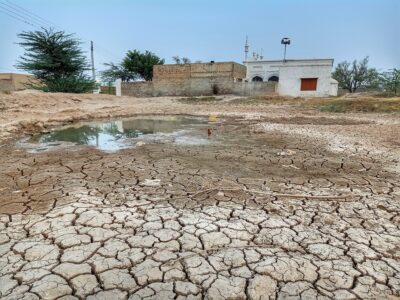
Jessica Fanzo has always been fascinated by food — something that she says may be linked with her Italian American upbringing, where food was central to her family and culture. Now a leading scholar in the transdisciplinary field of food systems, she will be joining the Columbia Climate School faculty in July.
Fanzo comes to the Climate School from Johns Hopkins University, where she was the Bloomberg Distinguished Professor of Global Food Policy and Ethics and the director of Hopkins’ Global Food Policy and Ethics Program.
She specializes in the interconnectedness of agriculture, health, and the environment. Her research aims to improve food systems to deliver healthy, equitable, and environmentally sustainable diets. She has over two decades of research and field experience working around the globe on food systems policy and food security. And, she’s served as an adviser for organizations including USAID, UN organizations including the World Health Organization, the World Food Programme, the Food and Agriculture Organization and the UN Committee on Food Security, the Rockefeller Foundation, and the World Bank.
Her new position will be her fourth tenure at Columbia, as she previously worked at the Earth Institute (which now forms the core of the Climate School), where she served as the director of nutrition policy at the Center on Globalization and Sustainable Development, as well as the nutrition director at the Center for Global Health and Economic Development. She has also held roles at the Columbia University Irving Medical Center and the School of International and Public Affairs, and did her postdoc at the College of Physicians and Surgeons back in 2000.
Can you share more about the focus of your research?
My research covers four main areas. The first is food systems analytics, which involves gathering data to help decisionmakers understand the state of food systems — and make more informed policy decisions about how to ensure food systems are delivering foods that are healthy, equitable, and environmentally sustainable. I’m working on two major initiatives in this realm, including the Food Systems Dashboard and the Food Systems Countdown Initiative. The Dashboard compiles food systems data in a visually appealing, accessible way, to provide policymakers with an understanding of a country’s food system and the biggest challenges it faces. And, the Food Systems Countdown is a collaborative effort of over 60 researchers to identify the most relevant indicators to track food systems performance and their success over the next decade. This framework can inform better policies and programs that address food security, diets, nutrition, health, and climate change.
Another area that I’m working on is understanding how foodscapes influence diets, like how different geography, land, or urban environments affect the dietary choices that are available to local communities. Geopolitics, climate change, and urbanization are changing many places, which, in turn, influences what kind of food is grown, available, and accessible. So, we want to better understand how places, and the drivers shaping those environments, are changing and how that influences diets. For example, we have a project in Cambodia looking at how climate change and how political decisions, like building more dams, are impacting the flow of the Mekong River — and how the altered flow affects food security and the dietary choices for the communities that depend on the river. A related four-year project is to better integrate and use climate services into public health programs that prevent and treat malnutrition in climate-vulnerable riverine and pastoralist communities in Cambodia and Ethiopia respectively.
The third area of research is on how to how to shift towards healthier and more sustainable diets — and what that means for the livestock sector and with the growing demand for animal-sourced foods. I was part of the EAT-Lancet Commission that laid out broad, global targets, but now the question is how to transform food systems in a way that does not create more inequities and injustices, while at the same time ensures both human and planetary health. It is the grand challenge of our time. The role of agrobiodiversity, local and traditional crops, and diversification of production systems will be critical.
And the fourth area of research is examining at the ethical debates in food systems policy and studying how to integrate human rights into food systems. For instance, we know that climate change, and the ways food systems are governed, are putting constraints on marginalized and vulnerable populations. So, how do we work with policymakers to protect food security and agriculture-based livelihoods among those populations and ensure that their rights are protected, particularly among those working in food systems in post-conflict and resource-constrained settings? We have a five-year project — “People Centered Food Systems”— that is integrating human rights into policy dialogues in Cambodia, Ethiopia, Honduras, and Uganda.

What drew you to this field?
I was fascinated by food, and how the body uses food for wellness. My undergraduate degree was in agriculture, but I completed both my masters and PhD in nutrition. I started my career as a bench science nutritionist, trying to understand how the human body responds to nutrients at the cellular-molecular level. Over time, I switched to a more public-facing career in international development — working in nutrition, but through a wider lens to better understand the connections of agriculture, climate change and food systems with diets, nutrition, and health. When I started my studies and subsequent research in nutrition, it was a niche field, and no one took great interest in food. Now, food is everywhere — and food systems are viewed as an important area of study because they touch upon every sector, system, and person on the planet. We all engage in food systems every day and make decisions that impact the global food system. And now, with the many challenges food systems face, particularly with climate change, we must figure out how to ensure people are food secure, and healthy, without decimating the environment. It doesn’t get more interesting and challenging than that!
What classes do you hope to teach at Columbia Climate School?
I think there’s a real yearning from students to have more classes on food and climate. I’ll definitely teach a food and climate course. And, I’ll explore what kinds of food system classes are currently offered to see how I can contribute. I’m also considering a class on food equity and ethics, which would look at why some people don’t have food security or are disproportionately suffering. We would examine the ethical challenges of feeding the world, including climate change and the political economy of food, and consider injustices that exist in parallel with food insecurity — and how to overcome them. I think this generation of students, like the students of the counterculture movement of the 1960s, is especially concerned about injustices and how to work toward a more equitable society.
What drew you to the Columbia Climate School? This position is actually a return to Columbia for you, correct?
I love Columbia. This will be my fourth time here, and I want to stay.
I’m really excited to join the Climate School, especially after being a part of the Earth Institute. There’s space to establish a powerhouse program on food systems, particularly in the context of climate change. I’ll be leading the interdisciplinary Food for Humanity Initiative that will engage schools across the university. It’s an amazing opportunity to deepen Columbia’s work across food and climate, and to build a strong collaborative program, with the Climate School spearheading this important work. There are many people doing amazing work on food and food systems across the entire university — and the Climate School can be the convener that brings everyone together to do impactful work right here in the city, but also globally.

What are your hopes for building out the Food for Humanity Initiative?
So much of that ideation and collaboration will happen once I get to Columbia. It will be a truly collaborative effort that everyone can feel ownership over. I’ll spend the first year really listening to collaborators and meeting everyone who studies or is interested in getting involved in food issues — to find out what they’re working on and what their hopes are. I do see three pillars of building a collaborative program: research, education, and policy.
Columbia sits in New York City, which is an exemplar city that many people look to for innovation, and a hub of global activity on policy issues. We have the potential to set a powerful example for what can work on food and climate policy initiatives, and engage and exchange with the many talented people working on food systems.
Why is interdisciplinary collaboration such an important component of this work?
It’s super necessary. I call climate change, “everything change,” because every sector, every system, every community, every individual is, and will continue to be, impacted by climate change. And, food systems are very similar because they’re a multifactorial issue and we all influence and engage with food systems in some way, shape, or form on a daily basis. The ways that food systems are connected to health, environment, livelihoods, and equity is a central issue around the world. It’s hard to ignore food systems and climate and their linkages with the way the world is moving right now. So, it’s critical to have multiple disciplines working together on the two vexing challenges of climate and food. We need all expertise and all hands on deck to address food and climate.




My interest is in paleoclimate. Two years ago we excavated a very small portion of a ridged garden in the Upper Peninsula of Michigan. Radio carbon dates are scarce for these gardens (and there are many) but they all are probably Menominee and date between 1200 and the 1800s. They are for raising maize and perhaps other minor crops. Climate variability had to have affected their yields. My wife and I grow the same kinds of maize. First we used hills and then switched to ridges. In all probability there was widespread drought in the mid- 1100s when chaos was rampant in Native settlements. Many moved west probably because the east was well populated people who were very capable of discouraging intruders. With all that I would like to know who studied and published the most on that 1100-1300 AD period in the middle and upper Midwest. I have read quite a bit about this but dendrochronology is not well developed in most of the area the between the Great Lakes and the Missouri River. No one seems to have a good grasp of what caused the collapse of Cahokia (on the east bank of the Mississippi River opposite present day St. Louis} An estimated 20-25000 people just vanished after about 1050 AD. Perhaps it was overpopulation, but think drought (bad here in Iowa now) certainly figured into a disaster.